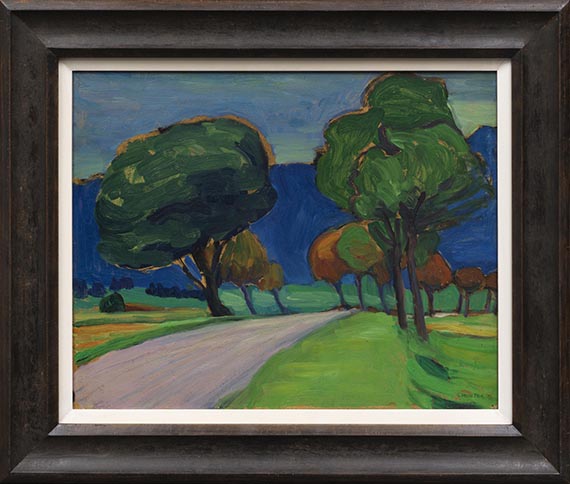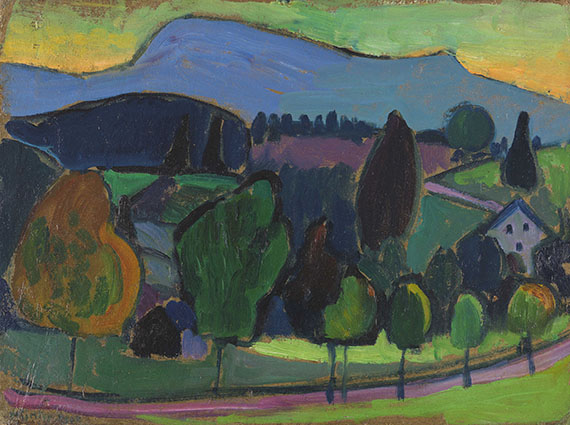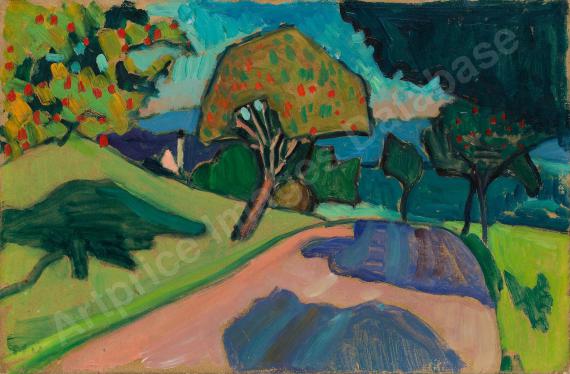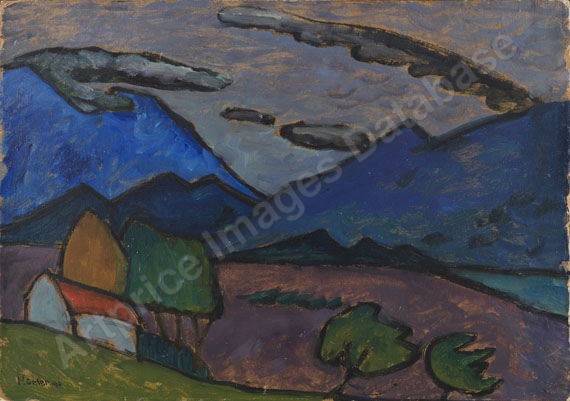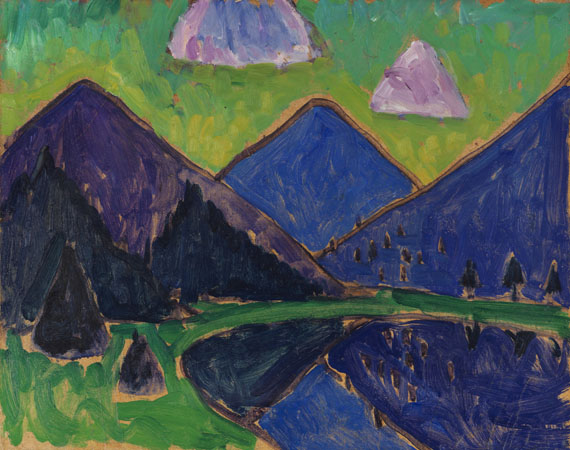2
Gabriele Münter
Straße nach Weilheim, 1908.
Oil on cardboard
Estimate:
€ 200,000 - 300,000
$ 214,000 - 321,000
Straße nach Weilheim. 1908.
Oil on cardboard.
Lower right signed and dated, inscribed "23" (by a hand other than that of the artist?). 32.9 x 40.9 cm (12.9 x 16.1 in).
With the inscription "4035" on the reverse.
• Masterpiece from the early Murnau period in 1908, the birth of German Expressionism.
• On their first visit in the summer of 1908, Gabriele Münter and Wassily Kandinsky fell in love with the 'Blue Land'.
• Paintings from this period are among her most sought-after works.
• Murnau landscape in the light of the blue hour - of museum quality.
• Part of a Swiss private collection for many decades
• This year Gabriele Münter is honored in numerous international museum exhibitions (Vienna, Madrid, London and Bern).
Accompanied by a written confirmation of authenticity issued by the Gabriele Münter- and Johannes Eichner-Foundation on December 7, 2023. The painting will be included into the forthcoming catalogue raisonné of Gabriele Münter's paintings.
PROVENANCE: Collection of Dr. med. dent. Detmar Haymann (1891-1985), Zürich.
Ever since family-owned.
Called up: June 7, 2024 - ca. 17.02 h +/- 20 min.
Oil on cardboard.
Lower right signed and dated, inscribed "23" (by a hand other than that of the artist?). 32.9 x 40.9 cm (12.9 x 16.1 in).
With the inscription "4035" on the reverse.
• Masterpiece from the early Murnau period in 1908, the birth of German Expressionism.
• On their first visit in the summer of 1908, Gabriele Münter and Wassily Kandinsky fell in love with the 'Blue Land'.
• Paintings from this period are among her most sought-after works.
• Murnau landscape in the light of the blue hour - of museum quality.
• Part of a Swiss private collection for many decades
• This year Gabriele Münter is honored in numerous international museum exhibitions (Vienna, Madrid, London and Bern).
Accompanied by a written confirmation of authenticity issued by the Gabriele Münter- and Johannes Eichner-Foundation on December 7, 2023. The painting will be included into the forthcoming catalogue raisonné of Gabriele Münter's paintings.
PROVENANCE: Collection of Dr. med. dent. Detmar Haymann (1891-1985), Zürich.
Ever since family-owned.
Called up: June 7, 2024 - ca. 17.02 h +/- 20 min.
"Straße nach Weilheim" (Road to Weilheim) can be brought in connection with a note in the archive of the Gabriele Münter and Johannes Eichner Foundation. It can be assumed that this work depicts the road to Weilheim. In 1908, the year it was built, today's Bundesstraße 2 was still a tranquil country road. Looking south, Gabriele Münter could see the mountain range on the horizon through the trees. It was precisely this view, which contains the essential elements of the so-called "Blaue Land" that fascinated the artist so much.
Our painting was created in what was arguably the most important year of Gabriele Münter's artistic career. In late summer, Gabriele Münter met up with Wassily Kandinsky, Alexej von Jawlensky and Marianne von Werefkin in Murnau for painting sessions. They stayed at the Griesbräu Inn on the Obermarkt and explored the surroundings of the small farming village with their easels and brushes, sketchpads, and pencils, rounded off by discussions about the latest artistic issues and new goals. They had all been traveling over the previous years and were able to draw on the impressions gathered. During this creative shared time away from the social conventions and constraints of Munich, an artistic revolution characterized by great dynamism happened, a radical departure from the Impressionist and late Impressionist style of painting. Here she made a decisive turn towards synthetic, expressive color painting, which would have a decisive influence on subsequent art history.
The vast landscape with the tree-lined avenue and the mountains is shown in homogeneously painted areas and framed by loosely set contours. Gabriele Münter only had to walk along the street that led from her accommodation at the time, the inn "Zum Griesbräu" inn, in the direction of Weilheim, and turn south a little outside the village, to enjoy this expansive view of the landscape, which would accompany her for many years to come and serve as a source of inspiration. In the autumn of 1908, the artist captured the atmospheric landscape with a few, slightly nuanced hues, which was entirely in line with the approach of her companion. (Quoted from: Helmut Friedel, Annegret Hoberg, Der Blaue Reiter, Munich 2000, p. 24).
Looking back in 1911, Gabriele Münter herself confirmed the relevance of the paintings created in the first Murnau autumn: "After a short period of agony, I made a great leap - from painting nature - more or less in impressionist style - to perceiving a meaning - to abstracting - to giving an extract" (B. Salmen, A. Hoberg, in: exhib. cat. 1908/2008 - Vor 100 Jahren. Kandinsky, Münter, Jawlensky, Werefkin in Murnau, Murnau 2008, p.24). Our painting, which has been in the family for many decades and has never been exhibited, is an important creation from this epochal period of awakening. [EH]
Our painting was created in what was arguably the most important year of Gabriele Münter's artistic career. In late summer, Gabriele Münter met up with Wassily Kandinsky, Alexej von Jawlensky and Marianne von Werefkin in Murnau for painting sessions. They stayed at the Griesbräu Inn on the Obermarkt and explored the surroundings of the small farming village with their easels and brushes, sketchpads, and pencils, rounded off by discussions about the latest artistic issues and new goals. They had all been traveling over the previous years and were able to draw on the impressions gathered. During this creative shared time away from the social conventions and constraints of Munich, an artistic revolution characterized by great dynamism happened, a radical departure from the Impressionist and late Impressionist style of painting. Here she made a decisive turn towards synthetic, expressive color painting, which would have a decisive influence on subsequent art history.
The vast landscape with the tree-lined avenue and the mountains is shown in homogeneously painted areas and framed by loosely set contours. Gabriele Münter only had to walk along the street that led from her accommodation at the time, the inn "Zum Griesbräu" inn, in the direction of Weilheim, and turn south a little outside the village, to enjoy this expansive view of the landscape, which would accompany her for many years to come and serve as a source of inspiration. In the autumn of 1908, the artist captured the atmospheric landscape with a few, slightly nuanced hues, which was entirely in line with the approach of her companion. (Quoted from: Helmut Friedel, Annegret Hoberg, Der Blaue Reiter, Munich 2000, p. 24).
Looking back in 1911, Gabriele Münter herself confirmed the relevance of the paintings created in the first Murnau autumn: "After a short period of agony, I made a great leap - from painting nature - more or less in impressionist style - to perceiving a meaning - to abstracting - to giving an extract" (B. Salmen, A. Hoberg, in: exhib. cat. 1908/2008 - Vor 100 Jahren. Kandinsky, Münter, Jawlensky, Werefkin in Murnau, Murnau 2008, p.24). Our painting, which has been in the family for many decades and has never been exhibited, is an important creation from this epochal period of awakening. [EH]
2
Gabriele Münter
Straße nach Weilheim, 1908.
Oil on cardboard
Estimate:
€ 200,000 - 300,000
$ 214,000 - 321,000
Buyer's premium, taxation and resale right compensation for Gabriele Münter "Straße nach Weilheim"
This lot can be subjected to differential taxation plus a 7% import tax levy (saving approx. 5 % compared to regular taxation) or regular taxation, artist‘s resale right compensation is due.
Differential taxation:
Hammer price up to 800,000 €: herefrom 32 % premium.
The share of the hammer price exceeding 800,000 € is subject to a premium of 27 % and is added to the premium of the share of the hammer price up to 800,000 €.
The share of the hammer price exceeding 4,000,000 € is subject to a premium of 22 % and is added to the premium of the share of the hammer price up to 4,000,000 €.
The buyer's premium contains VAT, however, it is not shown.
Regular taxation:
Hammer price up to 800,000 €: herefrom 27 % premium.
The share of the hammer price exceeding 800,000 € is subject to a premium of 21% and is added to the premium of the share of the hammer price up to 800,000 €.
The share of the hammer price exceeding 4,000,000 € is subject to a premium of 15% and is added to the premium of the share of the hammer price up to 4,000,000 €.
The statutory VAT of currently 19 % is levied to the sum of hammer price and premium. As an exception, the reduced VAT of 7 % is added for printed books.
We kindly ask you to notify us before invoicing if you wish to be subject to regular taxation.
Calculation of artist‘s resale right compensation:
For works by living artists, or by artists who died less than 70 years ago, a artist‘s resale right compensation is levied in accordance with Section 26 UrhG:
4 % of hammer price from 400.00 euros up to 50,000 euros,
another 3 % of the hammer price from 50,000.01 to 200,000 euros,
another 1 % for the part of the sales proceeds from 200,000.01 to 350,000 euros,
another 0.5 % for the part of the sale proceeds from 350,000.01 to 500,000 euros and
another 0.25 % of the hammer price over 500,000 euros.
The maximum total of the resale right fee is EUR 12,500.
The artist‘s resale right compensation is VAT-exempt.
Differential taxation:
Hammer price up to 800,000 €: herefrom 32 % premium.
The share of the hammer price exceeding 800,000 € is subject to a premium of 27 % and is added to the premium of the share of the hammer price up to 800,000 €.
The share of the hammer price exceeding 4,000,000 € is subject to a premium of 22 % and is added to the premium of the share of the hammer price up to 4,000,000 €.
The buyer's premium contains VAT, however, it is not shown.
Regular taxation:
Hammer price up to 800,000 €: herefrom 27 % premium.
The share of the hammer price exceeding 800,000 € is subject to a premium of 21% and is added to the premium of the share of the hammer price up to 800,000 €.
The share of the hammer price exceeding 4,000,000 € is subject to a premium of 15% and is added to the premium of the share of the hammer price up to 4,000,000 €.
The statutory VAT of currently 19 % is levied to the sum of hammer price and premium. As an exception, the reduced VAT of 7 % is added for printed books.
We kindly ask you to notify us before invoicing if you wish to be subject to regular taxation.
Calculation of artist‘s resale right compensation:
For works by living artists, or by artists who died less than 70 years ago, a artist‘s resale right compensation is levied in accordance with Section 26 UrhG:
4 % of hammer price from 400.00 euros up to 50,000 euros,
another 3 % of the hammer price from 50,000.01 to 200,000 euros,
another 1 % for the part of the sales proceeds from 200,000.01 to 350,000 euros,
another 0.5 % for the part of the sale proceeds from 350,000.01 to 500,000 euros and
another 0.25 % of the hammer price over 500,000 euros.
The maximum total of the resale right fee is EUR 12,500.
The artist‘s resale right compensation is VAT-exempt.




 Lot 2
Lot 2 